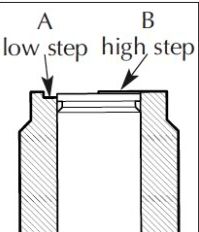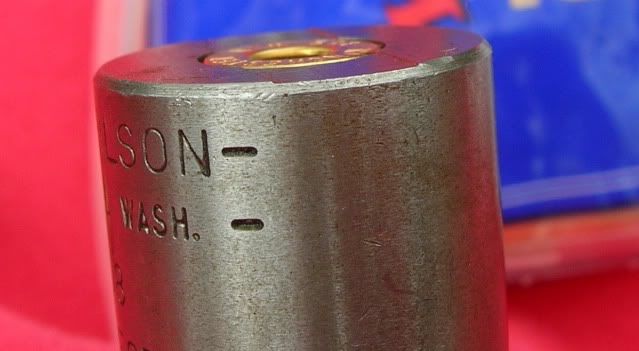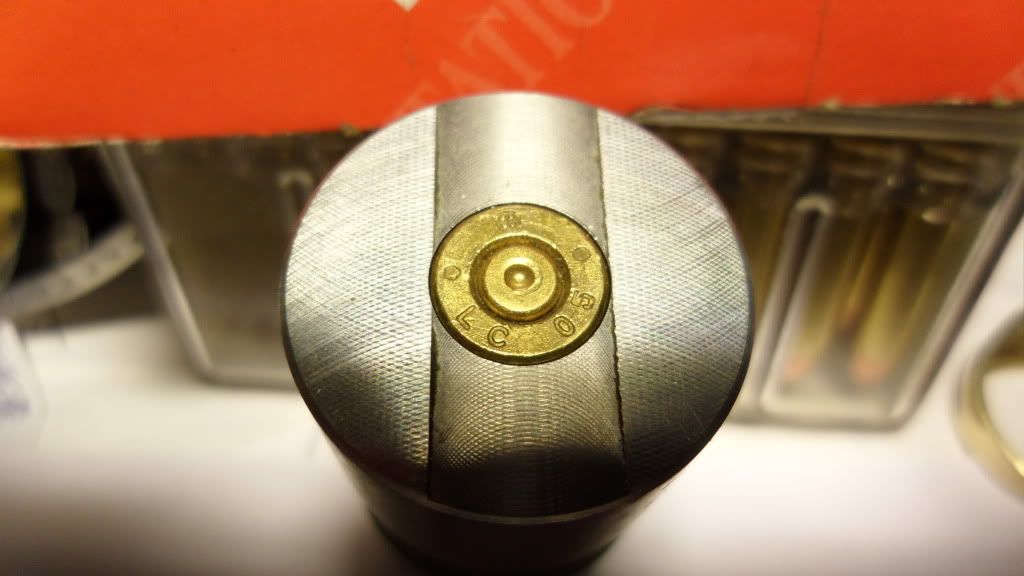
 |
|
|||||||
| Forum Rules | Firearms Safety | Firearms Photos | Links | Library | Lost Password | Email Changes |
| Register | FAQ | Calendar | Today's Posts | Search |
 |
|
|
Thread Tools | Search this Thread |
|
|
#1 |
|
Member
Join Date: February 20, 2012
Posts: 52
|
The need for a case guage
When I reload, I always do the plunk test in the chamber of the particular handgun that I will be using the particular rounds in. I do not own a case gauge.
What does buying a case gauge get me that is not already achieved by doing the plunk test in the actual chamber itself? |
|
|
|
|
#2 |
|
Senior Member
Join Date: December 27, 2008
Posts: 555
|
When loading for a single gun?, not much, except for possible excessive headspace issues.
The gauge allows one to be sure the sizing and crimping dies are set correctly. For instance, with the 9mm, it is possible to taper crimp too much. The round will still chamber and fire, but excessive headspace puts undo strain on the extractor and often leads to less than ideal accuracy. The case gauge also allows one to be pretty sure that the rounds will chamber (both for headspace and OAL) correctly in all guns of that caliber without having to do a 'plunk test' in all of them beforehand. Of course there are occasional exceptions with some gun chambers, but not many. My take, JT |
|
|
|
|
#3 |
|
Senior Member
Join Date: May 27, 2007
Posts: 5,261
|
I have not found a need for cartridge gauges in handgun calibers. For me though, I did find I needed them for rifle cartridges.
The typical advice in setting up a rifle die is to the shell holder plus a quarter turn. Once I purchased cartridge gauges I found this advice to be rubbish as none of my cartridges were correctly sized. The shoulder to base, the "cartridge headspace" distance should be between these lines"  In practice, the distance between Go and No Go is only 0.006" and without cartridge headspace gauges, it is difficult to correctly set up the rifle dies. For my M70's, M1903's, and M98's, I can take the firing pin mechanism out and lightly cam down the bolt and tell just when the case is properly sized. However, that did not work with a M1917 because the bolt cams forward, it will not work with a M700 or a Garand unless I remove the extractor and spring loaded ejector. It has been a long while since I took the firing pin mechanism out of a M700, post WW2 rifles were designed on the assumption that no one cleans the mainspring or firing pin.  If the cartridge is too fat that will cause malfunctions in semi auto rifles, in Garands/M14's/M1a's/M1 Carbines/Mini 14's too long and too fat cartridges have caused out of battery slamfires, so getting the cartridge to the proper diameter and length is a safety consideration for the Garand type action. These gages from Sheridan were cut with a SAAMI minimum reamer, and they have a port, so you can see if you have clearance. I think these are a hoot and I have a set in 308 and 30-06, because I have 30-06, 308 Garands and of course, I have M1a's. 
__________________
If I'm not shooting, I'm reloading. |
|
|
|
|
#4 | |
|
Senior Member
Join Date: March 8, 2013
Location: Rittman, Ohio
Posts: 2,074
|
Quote:
|
|
|
|
|
|
#5 | |||
|
Senior Member
Join Date: July 18, 2008
Posts: 7,249
|
Quote:
Quote:
The Wilson case gage is not a stand alone gage; it is a datum based gage. At the bottom of the hole in the gage is a datum, the datum at the bottom of the hole measures 3/8" or .375" for the 30/06. And then the clever part, to make the datum case friendly Wilson put a radius on the datum. From the big inning I have suggested reloaders measure before and again after, the standard response from that suggestions; "I do not see any advantage to measuring before and again after firing". Those that can not see an advantage to measuring before and again after have no clue what to do with the Wilson case gage; it seems the gage is smarter than some users. If a reloadr measures the length of the casae from the shoulder to the case head before firing and again after firing they will know what effect the chamber had on the case when fired. Measure before and again after: Now that the case has been fired it is time to size the case. Before sizing measured the length of the case from the shoulder to the case head. And then adjust the die. And then size the case and measure the length of the case from the shoulder to the case head again. If the reloader can remember the length of the case after firing and is able to subtract the length of the case from the shoulder to the case head after sizing they can determine the clearance between the sized case and chamber. The Wilson case gage was designed to measure the length of the case from the shoulder to the case head on fired and sized cases; meaning the Wilson case gage does not measure the diameter of the case. It can be used to measure the diameter of the case the problem comes when trying to convince a reloader it can be done. It reminds me of Jimmy Dean talking about the reason a chicken crossed the road; he said the chicken crosses the road to show the opossum it can be done. I thought at one time reloaders were capable of understanding the datum and all they needed was a datum. I was wrong. I use shot out barrels to make gages, I use take off barrels as gages and I use new barrels as gages, all I need is a round hole/datum for the case shoulder to sit on and I am the fan of measuring before and again after. The before and after include before firing and again after firing and before sizing and again after sizing. Quote:
F. Guffey |
|||
|
|
|
|
#6 |
|
Member
Join Date: February 20, 2012
Posts: 52
|
Great explanations, thanks. I reload only for handgun so, for now, I'll hold off with the case gauges for now.
|
|
|
|
|
#7 | |
|
Senior Member
Join Date: December 17, 2005
Location: Swamp dweller
Posts: 6,187
|
Quote:
For what its worth if you reloads pass the plunk test you are good to go and there is no need for a case gauge.
__________________
NRA Life Member, NRA Chief Range Safety Officer, NRA Certified Pistol Instructor,, USPSA & Steel Challange NROI Range Officer, ICORE Range Officer, ,MAG 40 Graduate As you are, I once was, As I am, You will be. |
|
|
|
|
|
#8 |
|
Senior Member
Join Date: December 4, 1999
Location: WA, the ever blue state
Posts: 4,678
|
Reading Wilson gauge instructions, watching Wilson gauge video, and making measurements of the case gauges with a depth micrometer and a handful of chamber go gauges, ... I have found inconsistencies and quality control problems.
The gauges are sometimes 0.0010" out of square. The slots on the bottom may be .005" or .010" despite what the instruction say. There are (4) important headspace and case space datums; SAAMI min and max chamber and min and max cartridge. Those are typically not next to each other with clearance, but overlapping with interference per SAAMI registration. The case gauge top of the slot on top is the only one to correspond. That is to max cartridge and will have an error of +/- 0.0010". Now that you know that.... see how many errors you can find in Wilson's case gauge video on youtube.
__________________
The word 'forum" does not mean "not criticizing books." "Ad hominem fallacy" is not the same as point by point criticism of books. If you bought the book, and believe it all, it may FEEL like an ad hominem attack, but you might strive to accept other points of view may exist. Are we a nation of competing ideas, or a nation of forced conformity of thought? |
|
|
|
|
#9 |
|
Senior Member
Join Date: April 10, 2008
Location: Alaska
Posts: 7,014
|
I got one when I started reloading 9mm.
Whoa, thqat thing is sticking up. Hmmm, well they were shooting good before it got here, hmmm Ok, take pistol apart, put bullet in barrel, fits fine. Put in gauge, head sticking up. Read instructions (again). Nope, supposed to be flat. Ok, note to self, it can stick up, just not too much. Are we dealing with as spot on SAMI specs vs a generous chamber or? Ahh who cares, its shoots fine and if it stickup up too much then its a reject. Off to shooting. note to self: don't buy any more gauges like that. |
|
|
|
|
#10 |
|
Senior Member
Join Date: February 13, 2002
Location: Canada
Posts: 12,453
|
The chamber beats any gauge every time.
Been loading everything from .38 Special to .30-06, for 40 some years, without ever spending a nickel of a gauge of any kind. They're primary purpose is to separate you from your money. A good Vernier is all you really need.
__________________
Spelling and grammar count! |
|
|
|
|
#11 |
|
Senior Member
Join Date: February 23, 2005
Posts: 13,195
|
I like the case gague...and to me its a great tool. In 9mm as an example, I have several guns...so rather than use the barrels to do the plunk test...I use a case gague.
I have them for all 7 of the handgun calibers I load for...and I recommend them. |
|
|
|
|
#12 |
|
Junior member
Join Date: February 27, 2015
Posts: 1,768
|
I take a different view...
If you are working out a load for ONE specific firearm, then what you worked out through trial & error works for YOU... If you are working up loads for several different firearms in the same caliber, Then a case gauge works as your 'Standard' since you are feeding different chambers, all different... When I chamber a barrel, I use the same chamber reamer to make the case gauge. If it fits in the gauge, it WILL fit in the barrel... Since 99.99999% of shooters will never own a custom chamber, Or have any idea what their chamber is actually shaped like, A case gauge is as good as anything since it approximates a SAAMI standard... Something that the vast majority of firearms owners will have no idea if the chamber is even close to SAAMI or not... I'm a stickler for chambers, Its simply too quick, easy & cheap to have a chamber checked and/or corrected to have some odd ball, blown out or misaligned chamber in a firearm, especally a rifle. Guys that are happy with fiddling around with an 'Off Spec' chamber because the have done the hit & miss thing and FINALLY found a way to leave the cases blown out to be mostly accurate, its good for them... When I tune a rifle up, I want it to be under MOA with a reasonable off the shelf ammo. Reloading to SAAMI specifications gives anyone a chance of sub MOA with reasonable ammo, when the rifle is set up correctly in the first place... And that ammo interchanges between rifles, its not a shelf queen that sits until you fire that 'Specific' firearm again. |
|
|
|
|
#13 |
|
Senior Member
Join Date: July 28, 2015
Location: Los Angeles, CA
Posts: 134
|
As others have said, if you only shoot one gun of a given caliber, i don't see a need. However, if you shoot your reloads in various calibers, then I use a Chamber Checker. It hasn't let me down yet.
My trickiest caliber so far is 9mm, I have to check pretty much every single one, but I own 4 handguns in that caliber. Much easier to use the chamber checker and they work in all if they pass. If they fail they go through the Bulger Buster and Voila! they work just fine. |
|
|
|
|
#14 |
|
Senior Member
Join Date: May 8, 2009
Location: Florida
Posts: 3,787
|
I find it convenient to have gages for 9 mm and for .380 ACP because I have multiple pistols in those calibers and I can be sure that if a round fits the gage it will fit the chamber of all of them. It is also very slightly more convenient to grab the gage off the shelf than to disassemble a pistol. It sure isn't a deal breaker, though.
|
|
|
|
|
#15 | |
|
Senior Member
Join Date: July 18, 2008
Posts: 7,249
|
Quote:
F. Guffey |
|
|
|
|
|
#16 |
|
Senior Member
Join Date: January 5, 2009
Location: Just off Route 66
Posts: 5,067
|
With the barrel out of the pistol, there are no problems using it for your gauge to see if the case is in the correct dimensions.
With rifle cases and revolvers it is a bit more problematic, removing the barrel from a rifle is never an easy task, so a case gauge is the next best solution. I have one for each of my major calibers that I load for (3 in all, 223, 243 and 270). It is always a good practice in setting up the dies to re-size the case to proper specs. It is also not always necessary. For bolt action rifles a simple "plunk test" is all that is needed to insure the shoulder is set correctly. But for semi-automatic rifles a case gauge is an indispensable tool.   Ues your own judgement as to if you think you need one or not. Stay safe. Jim
__________________
Si vis pacem, para bellum |
|
|
 |
|
|